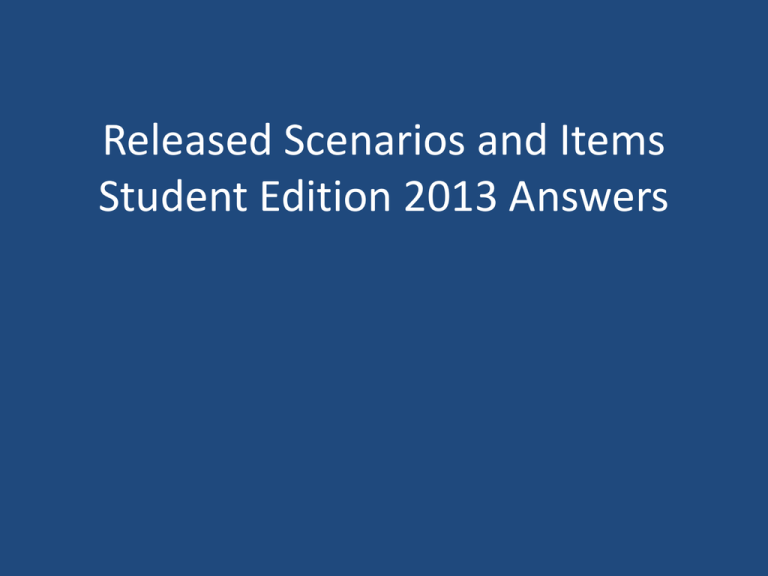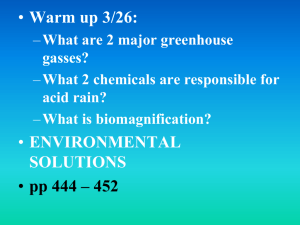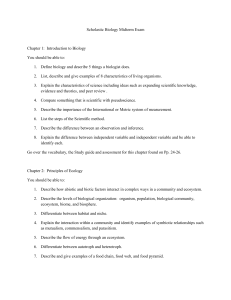Released Scenario 2013 Answers and Explanations
advertisement

Released Scenarios and Items Student Edition 2013 Answers 1. The traits of populations in the forest ecosystem have changed over time. What caused the traits to change? • Correct Response: A • Biology Skill: Biological evolution 2. Which change to the forest ecosystem could limit the growth of the tussock moth population? • Correct Response: D • Biology Skill: Ecosystems 3. Students asked the following question. Question: What is the effect of the size of a moth population on the growth of trees in an ecosystem? Which reason describes why this question is scientifically testable? • Correct Response: D • Biology Skill: Inquiry – Explain whether a given question can be investigated scientifically. 4. Unintended consequences Effect on a part of the forest ecosystem: 1. Water is polluted/Insecticide gets into water 2. Air is polluted 3. Other insects die 4. Other plants die 5. Less food for birds 6. Biomagnification/Builds up in food chain 7. Increase in forest fires 8. Decrease in the biodiversity of plants in the ecosystem Change in another part of the forest ecosystem: 1. Fewer/harms fish/aquatic insects/aquatic plants 2. Fewer insects/birds 3. Less food for birds 4. Less food for other animals and insects 5. Predators of the birds decrease in population 6. Kills/harms predators 7. Animals lose habitat/harm to people/animals 8. Some animals would lose their plant food source Continued #4 One example: All of the moths will die or have the poison on them and get into the water supply. That will pollute the water and kill the animals that drink it. Second example: All the moths will be gone and no more will be reproduced. This means that the birds will die because their food source will be gone. 5. In some species of moths, large wings are dominant over small wings, and yellow wings are dominant over white wings. What percent of the offspring of two moths with small white wings will also have small white wings? • Correct Response: D • Biology Skill: Structures and Functions of Living Organisms 6. How do tussock moths obtain energy in cellular respiration? • Correct Response: C • Biology Skill: Structures and Functions of Living Organisms 8. Paige and Logan counted a total of 480 plants in 12 square meters. What was the population density of these plants? • Correct Response: A • Biology Skill: Ecosystems • Calculate population density (total plants divided by square meters) 9. How would a fish population affect the stream ecosystem? • Correct Response: D • Biology Skill: Ecosystems 10. A year after their field study, Paige and Logan collected new data and found an average of only 5 plants at locations two meters from the stream. Which could explain why the number of plants two meters from the stream decreased? • Correct Response: B • Biology Skill: Inquiry • Explain inconsistencies in findings from a given investigation. 11. Why do frogs and fish in the stream have similar genes? • Correct Response: B • Biology Skill: Biological evolution • Describe that genes in very different organisms can be similar because the organisms all share a common ancestor. 12. People often build homes near streams. Which action represents sustainable use of resources in the construction of new homes? • Correct Response: C • Biology Skill: Ecosystems • Describe how sustainable development could help with a current resource issue. Item #13 – Procedure writing Perfect response example: 1. 2. 3. 4. 5. 6. Record the temperature and weather conditions. Measure the depth of the stream. Place a thermometer on the surface of the stream. Record the temperature. Wait 5 minutes. Repeat 3-5 for trials 2 and 3, placing the thermometer at the same spot. 7. Repeat steps 3-6 for half the depth of the stream and full depth of the stream. 8. Calculate the average temperature for each depth. Item #13 – Procedure writing Attributes required for procedure writing: Method for Collecting Data – the procedure states or implies a consistent sampling strategy or technique Example: Same stream, single day, same time of day Item #13 – Procedure writing Attributes required for procedure writing: Conditions to be Compared – Only one independent variable (water depth) is identified or implied in the procedure or data table (if given). The independent variable must have at least three conditions to be credited. Item #13 – Procedure writing Attributes required for procedure writing: Data to be Collected – The data collected to answer the question (water temperature) is identified or implied in the procedure or data table (if given). Item #13 – Procedure writing Attributes required for procedure writing: Record Measurements – The procedure states or implies measurements are recorded. Example: Record the temperature for each water depth. (take measurement or to count cannot be used to mean recorded) Item #13 – Procedure writing Attributes required for procedure writing: Observations are Repeated – More than one observation for all conditions is planned, or implied in a data table Example: Find 3 locations for each water depth Item #13 – Procedure writing Attributes required for procedure writing: Record Environmental Conditions – procedure identifies or implies recorded observations of at least one local environmental condition that might have an effect on the focus variables Example: Record air temperature, record time of day Item #13 – Procedure writing Attributes required for procedure writing: Logical Steps – the steps of the procedure are detailed enough to repeat the procedure effectively Examples of illogical steps: No ending time indicated, no limitation to the sampling area is given, recording vague data or results Basic test-taking techniques • Go through entire test – do ones you know for SURE • Mark ones to come back to • Upon going back, – For multiple choice, try to rule out some choices – Be able to say in your head why the answer is wrong or why right – GUESS. No penalty. • Short answer format – did you address ALL parts of the prompt






